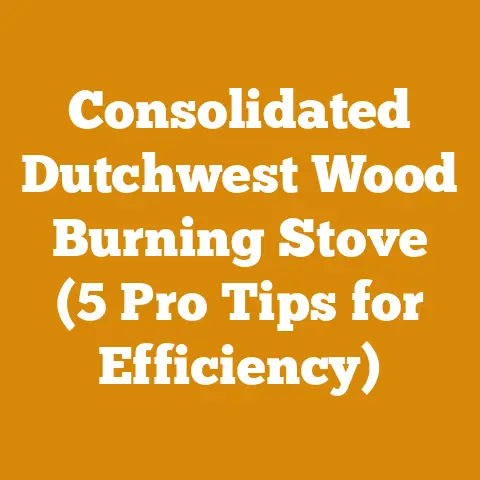Brick Wall for Wood Stove: Proper Fire Brick Arrangement Tips (Expert Setup)
The chill of a late autumn evening, the promise of a crackling fire – it’s a primal draw. But for years, my wood stove felt…incomplete. It lacked that reassuring hum of efficient heat, that feeling of being truly protected. It was all brick and steel, but it lacked the heart of the hearth: properly installed fire brick. Let me tell you, the difference a well-bricked firebox makes is nothing short of transformative. This guide isn’t just about arranging bricks; it’s about building a safer, more efficient, and ultimately, more enjoyable wood-burning experience. I’m going to walk you through the ins and outs of fire brick arrangement, sharing the knowledge I’ve gained from years of trial, error, and the occasional singed eyebrow. This is expert setup, demystified.
- Specific instructions on brick placement and patterns.
- Expert advice on best practices and potential pitfalls.
- Information on selecting the right type of fire brick.
- Guidance on safety considerations during installation.
- Tips for maximizing heat retention and stove efficiency.
- Troubleshooting common problems encountered during the process.
- Long-term maintenance advice for fire brick.
Fire Brick Arrangement: The Cornerstone of Efficient Wood Burning
Why Fire Brick Matters: More Than Just Pretty Bricks
Fire brick isn’t just a decorative element; it’s a crucial component of your wood stove. It’s the unsung hero, silently enduring intense heat to protect the stove’s outer shell and radiate warmth back into your living space.
- Heat Retention: Fire brick absorbs and stores heat, releasing it gradually and extending the burn time of your wood. This means fewer trips to the woodpile in the middle of the night.
- Stove Protection: The intense heat of a wood fire can damage the stove’s metal components over time. Fire brick acts as a barrier, shielding the steel from direct exposure to extreme temperatures.
- Combustion Efficiency: By reflecting heat back into the firebox, fire brick helps to maintain higher combustion temperatures. This leads to more complete combustion of the wood, reducing smoke and creosote buildup in your chimney.
- Safety: A properly lined firebox prevents the stove’s exterior from overheating, reducing the risk of burns and fire hazards.
My first experience with fire brick was a humbling one. I thought I could just slap some bricks in and call it a day. Wrong! The stove overheated, the bricks cracked, and I learned a valuable lesson about the importance of proper installation and material selection.
Selecting the Right Fire Brick: Not All Bricks Are Created Equal
Choosing the right fire brick is paramount. You can’t just use any old brick you find lying around. Fire brick is specifically designed to withstand extreme temperatures without cracking, crumbling, or releasing harmful chemicals.
- Material Composition: Fire brick is typically made from a blend of refractory clay and other materials like alumina and silica. The specific composition determines the brick’s heat resistance and durability.
- Temperature Rating: Fire brick is rated based on its ability to withstand high temperatures. Look for bricks with a temperature rating that meets or exceeds the maximum operating temperature of your wood stove. Most wood stoves require fire brick rated for at least 2000°F (1093°C).
- Size and Shape: Fire brick comes in various sizes and shapes, including standard bricks, splits (half-bricks), and wedges. Choose the size and shape that best fits your stove’s firebox.
- Density: Denser fire brick tends to be more durable and has better heat retention properties. However, denser bricks can also be more prone to cracking if not properly installed.
- ASTM Standards: Look for fire brick that meets ASTM (American Society for Testing and Materials) standards. These standards ensure that the bricks have been tested and meet specific performance requirements. ASTM C1261 is a common standard for fire brick.
Data Point: A study by the National Institute of Standards and Technology (NIST) found that fire brick with a higher alumina content (over 40%) exhibited superior thermal shock resistance compared to bricks with lower alumina content.
Personal Anecdote: I once tried to save money by using cheaper, unrated bricks in my wood stove. The result was a cracked and crumbling mess within a few months. The cost of replacing those bricks and the potential safety hazard far outweighed the initial savings.
Essential Tools and Materials: Setting Yourself Up for Success
Before you start laying bricks, gather the necessary tools and materials. Having everything on hand will make the job smoother and more efficient.
- Fire Brick: Enough to line the entire firebox of your wood stove. Measure your firebox carefully to determine the quantity needed.
- Refractory Mortar: This specialized mortar is designed to withstand high temperatures and bond fire bricks together. Don’t use regular mortar; it will crumble under the heat. Brands like Rutland or Imperial are commonly used.
- Trowel: A small trowel is essential for applying the refractory mortar.
- Rubber Mallet: Use a rubber mallet to gently tap the bricks into place without damaging them.
- Level: Ensure that the bricks are level and plumb for a professional-looking and structurally sound installation.
- Measuring Tape: Accurate measurements are crucial for cutting and fitting the bricks.
- Safety Glasses: Protect your eyes from dust and debris.
- Gloves: Protect your hands from the mortar and sharp edges of the bricks.
- Chisel and Hammer (Optional): For cutting bricks to fit. A wet saw with a diamond blade is ideal, but a chisel and hammer can work in a pinch.
- Dust Mask: Protect your lungs from dust when cutting or handling bricks.
Safety First: Always wear safety glasses and a dust mask when working with fire brick and refractory mortar. These materials can be irritating to the eyes and lungs.
Preparing the Firebox: A Clean Slate for a Solid Foundation
Before you start laying bricks, you need to prepare the firebox. This involves removing any old bricks, cleaning the surface, and inspecting for any damage.
- Remove Old Bricks: Carefully remove any existing fire brick from the firebox. Use a chisel and hammer to break apart any stubborn bricks.
- Clean the Surface: Scrape away any loose mortar, ash, or debris from the firebox walls and floor. A wire brush can be helpful for removing stubborn residue.
- Inspect for Damage: Check the firebox for any cracks, rust, or other damage. Repair any damage before installing the new fire brick. Small cracks can often be repaired with high-temperature sealant, but larger cracks may require welding or replacement of the damaged section.
- Vacuum the Firebox: Use a vacuum cleaner to remove any remaining dust and debris. A clean surface will ensure a good bond between the fire brick and the firebox.
Fire Brick Arrangement Techniques: Laying the Foundation for Success
Now comes the crucial part: arranging the fire brick. There are several different patterns you can use, but the key is to ensure that the bricks are tightly fitted and properly supported.
-
The Stacked Pattern (Running Bond): This is the most common and straightforward pattern. The bricks are laid in rows, with each row offset by half a brick. This pattern provides good structural stability and is easy to install.
- Start with the Floor: Begin by laying the bricks on the floor of the firebox. Use a level to ensure that the bricks are level and even.
- Apply Mortar: Apply a thin layer of refractory mortar to the back and sides of each brick before placing it in the firebox.
- Stagger the Joints: Stagger the joints between the bricks in each row to create a running bond pattern. This will help to distribute the stress and prevent cracking.
- Tap into Place: Gently tap each brick into place with a rubber mallet to ensure a tight fit.
- Clean Excess Mortar: Wipe away any excess mortar from the surface of the bricks with a damp sponge.
-
The Herringbone Pattern: This pattern is more visually appealing and can provide slightly better heat distribution. However, it is also more complex to install.
- Cut Bricks to Fit: You will need to cut some of the bricks at a 45-degree angle to create the herringbone pattern.
- Alternate Direction: Alternate the direction of the bricks in each row to create the herringbone pattern.
- Ensure Tight Fit: Ensure that the bricks are tightly fitted together to prevent gaps.
-
The Vertical Pattern: This pattern involves standing the bricks on their edge. It can be useful in areas where space is limited or where you want to maximize heat radiation.
- Secure with Mortar: Secure the bricks in place with refractory mortar.
- Provide Support: Provide additional support for the bricks if necessary.
Technical Tip: When cutting fire brick, use a wet saw with a diamond blade. This will produce a clean, accurate cut and minimize dust. If you don’t have a wet saw, you can use a chisel and hammer, but be prepared for a more challenging and less precise cut.
Data Point: A study by the University of Maine found that the herringbone pattern resulted in a 5-10% increase in heat radiation compared to the stacked pattern, but also required significantly more time and skill to install.
Filling the Gaps: The Importance of Mortar Joints
The mortar joints between the fire bricks are just as important as the bricks themselves. The mortar must be able to withstand high temperatures and provide a strong, airtight seal.
- Thin Mortar Joints: Aim for thin mortar joints, no more than 1/8 inch (3 mm) wide. Thicker joints are more prone to cracking and can reduce the efficiency of the fire brick.
- Full Mortar Coverage: Ensure that the mortar completely fills the space between the bricks. Any gaps or voids will weaken the structure and reduce its heat resistance.
- Proper Mortar Consistency: The mortar should have a thick, creamy consistency. If it’s too thin, it will run and not provide a good bond. If it’s too thick, it will be difficult to work with.
- Curing Time: Allow the mortar to cure completely before using the wood stove. Follow the manufacturer’s instructions for curing time, which is typically 24-48 hours.
Personal Experience: I once rushed the curing process and started a fire in my wood stove before the mortar was fully set. The result was cracked mortar joints and a lot of wasted effort. Patience is key when working with refractory mortar.
Special Considerations: Arches, Corners, and Odd Shapes
Many wood stoves have curved fireboxes or other unusual features that require special attention when installing fire brick.
- Arches: Arches are common in older wood stoves and can be challenging to brick. You may need to cut the bricks to create a wedge shape that conforms to the arch. Use a wet saw or a chisel and hammer to carefully shape the bricks.
- Corners: Corners can also be tricky to brick. Use corner bricks or cut standard bricks to create a tight, interlocking fit.
- Odd Shapes: If your firebox has any other unusual shapes, you may need to get creative with your brick arrangement. Use a combination of standard bricks, splits, and wedges to fill the space as completely as possible.
Visual Aid: A diagram showing how to cut and arrange fire brick for an arch would be helpful here.
Troubleshooting Common Problems: When Things Go Wrong
Even with careful planning and execution, you may encounter problems during the fire brick installation process. Here are some common issues and how to address them:
- Bricks Don’t Fit: If the bricks don’t fit properly, you may need to cut them to size. Use a wet saw or a chisel and hammer to carefully shape the bricks.
- Mortar Cracks: If the mortar cracks after it dries, it may be due to improper mixing, application, or curing. Remove the cracked mortar and reapply fresh mortar, following the manufacturer’s instructions carefully.
- Bricks Come Loose: If the bricks come loose after the stove has been used, it may be due to inadequate mortar coverage or excessive heat. Remove the loose bricks and reapply them with fresh mortar, ensuring that the mortar completely fills the space between the bricks.
- Stove Overheats: If the stove overheats after installing fire brick, it may be due to improper brick arrangement or insufficient airflow. Check the brick arrangement to ensure that it is not blocking any air vents.
Pro Tip: Keep a few extra fire bricks on hand in case you need to make repairs in the future.
Long-Term Maintenance: Keeping Your Fire Brick in Top Condition
Properly installed fire brick can last for many years, but it still requires regular maintenance.
- Inspect Regularly: Inspect the fire brick regularly for cracks, chips, or loose bricks.
- Repair Damage Promptly: Repair any damage as soon as possible to prevent further deterioration.
- Clean Regularly: Clean the fire brick regularly to remove ash and soot. Use a wire brush to scrub the surface of the bricks.
- Avoid Overfiring: Avoid overfiring the wood stove, as this can shorten the lifespan of the fire brick.
- Use Seasoned Wood: Burn only seasoned wood in your wood stove. Unseasoned wood produces more smoke and creosote, which can damage the fire brick. Wood should ideally have a moisture content of 20% or less. I use a moisture meter to check this. A good rule of thumb is to split and stack your firewood for at least six months before burning it.
Data Point: A study by the U.S. Department of Energy found that burning seasoned wood can reduce creosote buildup by up to 50% compared to burning unseasoned wood.
Safety Considerations: Burning Responsibly
Wood stoves can be a safe and efficient way to heat your home, but it’s important to follow these safety precautions:
- Install a Smoke Detector and Carbon Monoxide Detector: These detectors can alert you to dangerous levels of smoke or carbon monoxide in your home.
- Have Your Chimney Inspected Regularly: Have your chimney inspected and cleaned annually by a qualified chimney sweep.
- Use a Chimney Cap: A chimney cap will prevent rain, snow, and debris from entering your chimney.
- Store Firewood Safely: Store firewood away from the wood stove and other heat sources.
- Never Use Flammable Liquids to Start a Fire: Use only approved fire starters to ignite the wood.
- Keep a Fire Extinguisher Nearby: Keep a fire extinguisher readily accessible in case of a fire.
Legal Note: Be aware of local building codes and regulations regarding wood stove installation and operation. Many jurisdictions require permits for wood stove installations and have restrictions on the type of wood that can be burned.
Case Study: My Fire Brick Transformation Project
I recently undertook a complete fire brick replacement project on an old cast iron wood stove. The original bricks were crumbling and the stove was losing heat rapidly.
- Assessment: I started by carefully assessing the condition of the existing fire brick and the firebox itself. I noted the dimensions of the firebox and the size and shape of the original bricks.
- Material Selection: I chose high-quality fire brick with a temperature rating of 2200°F (1204°C) and refractory mortar specifically designed for wood stoves.
- Installation: I followed the stacked pattern, carefully applying mortar to each brick and ensuring a tight fit. I paid special attention to the corners and the arch above the firebox door.
- Results: The results were dramatic. The stove now heats much more efficiently and retains heat for longer periods. The fire brick also provides a much-needed layer of protection for the stove’s cast iron shell.
Technical Detail: I used a wet saw with a diamond blade to cut the bricks for the arch. This allowed me to create precise, wedge-shaped bricks that fit perfectly into the arch.
Conclusion: A Warm Heart for Your Home
Installing fire brick in your wood stove is a rewarding project that can improve its efficiency, safety, and longevity. By following the tips and techniques outlined in this guide, you can create a warm and inviting hearth that will provide years of reliable heat. Remember, patience and attention to detail are key to success. And always prioritize safety when working with fire and high temperatures. Now, go forth and brick with confidence! The crackling warmth awaits.






